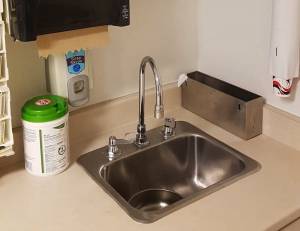A study of healthcare facilities from the World Health Organisation and UNICEF in 54 low- and middle-income countries has found that thirty eight per cent lacked access to a safe water source. Moreover, even facilities that rely on improved water sources without some kind of treatment could still be at risk. Water Mission has found that over 50% of the groundwater samples taken from “protected” boreholes have tested positive for fecal contamination.
Our water quality
In the United Kingdom we obviously don’t face the same dangers and the water is much safer in general, however it is still extremely important to regularly check the water quality of our healthcare facilities to look for pathogens such as Legionella bacteria with a thorough Legionella risk assessment from a qualified professional organisation or expert.
Risks for the low-income countries
The aforementioned lack of reliable safe water creates a particularly dangerous situation for vulnerable people who are susceptible to additional infections spread by unsafe drinking water, unsterilised instruments as well as limited hand washing facilities. A recent study estimated that almost 20% of patients in low-income countries contracts a healthcare-acquired infection.

As these studies show, low water quality in hospitals and healthcare facilities can negatively impact the health of patients and actually increase the spread of disease. It’s critical to establish safe water services that include consistent water treatment and testing in these settings before an outbreak happens.
Transformational water treatment solutions are actually available and can be easily incorporated into healthcare facility water supplies. There are devices that can passively add chlorine to water, which helps eliminate the risk of most life-threatening waterborne diseases and can actually be used to maintain hygienic conditions and eventually prevent the spread of illnesses. One such product, used in low-income countries, is the Water Mission erosion chlorinator. This device can add chlorine residual to water as it is pumped from a groundwater source and stored in a tank, guaranteeing that the water distributed through faucets is safe. Thanks to this solution, there is no need to batch-mix chlorine solution on a daily basis, which can eventually lead to inconsistent results. This device is refilled with chlorine tablets once every few weeks.
For water sources with inconstant turbidity, we can use a multi-stage treatment system. This system includes filtration, flocculation and chlorine disinfection. One of these treatment solutions is usually included in safe water projects supported in low-income countries.

These treatment solutions are only as effective as the system that is in place to adequately test and monitor the water quality. Water testing can be carried out with simple and affordable products, which can be conducted by healthcare facility staff after a very basic training. This training helps healthcare providers to test their own water and guarantee it continues to be safe to drink.
Access to safe drinking-water is an essential requirement for proper health and is also a human right. Access to safe drinking-water globally is monitored by the World Health Organisation and UNICEF using the indicator of “use of an improved source,” it does not account for water quality measurements. The objective here is to determine whether water from “enhanced” or “improved” sources is less probable to contain fecal contamination than “unimproved” sources and to assess the extent to which contamination can vary by source type and setting.
Accomplishments of Water Mission
Since 2014, Water Mission has worked in healthcare facilities in low-income countries like Liberia’s healthcare facilities, serving around 20,000 people to date with more than thirty safe water projects. Now, with solutions that appropriately disinfect the water, healthcare staff members have access to safe water to protect their patients and avoid further infections.
Water Mission is a nonprofit engineering organisation that designs, builds and implements safe water, sanitation and hygiene (WASH) solutions for individuals in developing countries and disaster areas. Water Mission has provided access to safe water for more than 7 million people in fifty-seven countries. They have more than four hundred staff members working around the globe in permanent country programs located in Africa, Asia and all over America, as well as the Caribbean. Here are some facts about the global water crisis:
- 443,000,000 school days are missed each year because of the global water crisis
- One person dies every thirty-seven seconds from water-related illnesses
- Over four billion people lack access to adequate sanitation
- Half of the developing world’s hospital beds are filled with people suffering from water-related diseases
